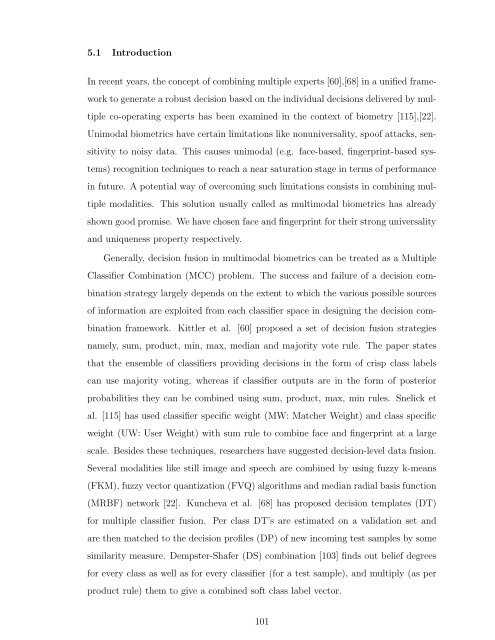Master Thesis - Department of Computer Science
Master Thesis - Department of Computer Science
Master Thesis - Department of Computer Science
Create successful ePaper yourself
Turn your PDF publications into a flip-book with our unique Google optimized e-Paper software.
5.1 Introduction<br />
In recent years, the concept <strong>of</strong> combining multiple experts [60],[68] in a unified frame-<br />
work to generate a robust decision based on the individual decisions delivered by mul-<br />
tiple co-operating experts has been examined in the context <strong>of</strong> biometry [115],[22].<br />
Unimodal biometrics have certain limitations like nonuniversality, spo<strong>of</strong> attacks, sen-<br />
sitivity to noisy data. This causes unimodal (e.g. face-based, fingerprint-based sys-<br />
tems) recognition techniques to reach a near saturation stage in terms <strong>of</strong> performance<br />
in future. A potential way <strong>of</strong> overcoming such limitations consists in combining mul-<br />
tiple modalities. This solution usually called as multimodal biometrics has already<br />
shown good promise. We have chosen face and fingerprint for their strong universality<br />
and uniqueness property respectively.<br />
Generally, decision fusion in multimodal biometrics can be treated as a Multiple<br />
Classifier Combination (MCC) problem. The success and failure <strong>of</strong> a decision com-<br />
bination strategy largely depends on the extent to which the various possible sources<br />
<strong>of</strong> information are exploited from each classifier space in designing the decision com-<br />
bination framework. Kittler et al. [60] proposed a set <strong>of</strong> decision fusion strategies<br />
namely, sum, product, min, max, median and majority vote rule. The paper states<br />
that the ensemble <strong>of</strong> classifiers providing decisions in the form <strong>of</strong> crisp class labels<br />
can use majority voting, whereas if classifier outputs are in the form <strong>of</strong> posterior<br />
probabilities they can be combined using sum, product, max, min rules. Snelick et<br />
al. [115] has used classifier specific weight (MW: Matcher Weight) and class specific<br />
weight (UW: User Weight) with sum rule to combine face and fingerprint at a large<br />
scale. Besides these techniques, researchers have suggested decision-level data fusion.<br />
Several modalities like still image and speech are combined by using fuzzy k-means<br />
(FKM), fuzzy vector quantization (FVQ) algorithms and median radial basis function<br />
(MRBF) network [22]. Kuncheva et al. [68] has proposed decision templates (DT)<br />
for multiple classifier fusion. Per class DT’s are estimated on a validation set and<br />
are then matched to the decision pr<strong>of</strong>iles (DP) <strong>of</strong> new incoming test samples by some<br />
similarity measure. Dempster-Shafer (DS) combination [103] finds out belief degrees<br />
for every class as well as for every classifier (for a test sample), and multiply (as per<br />
product rule) them to give a combined s<strong>of</strong>t class label vector.<br />
101










